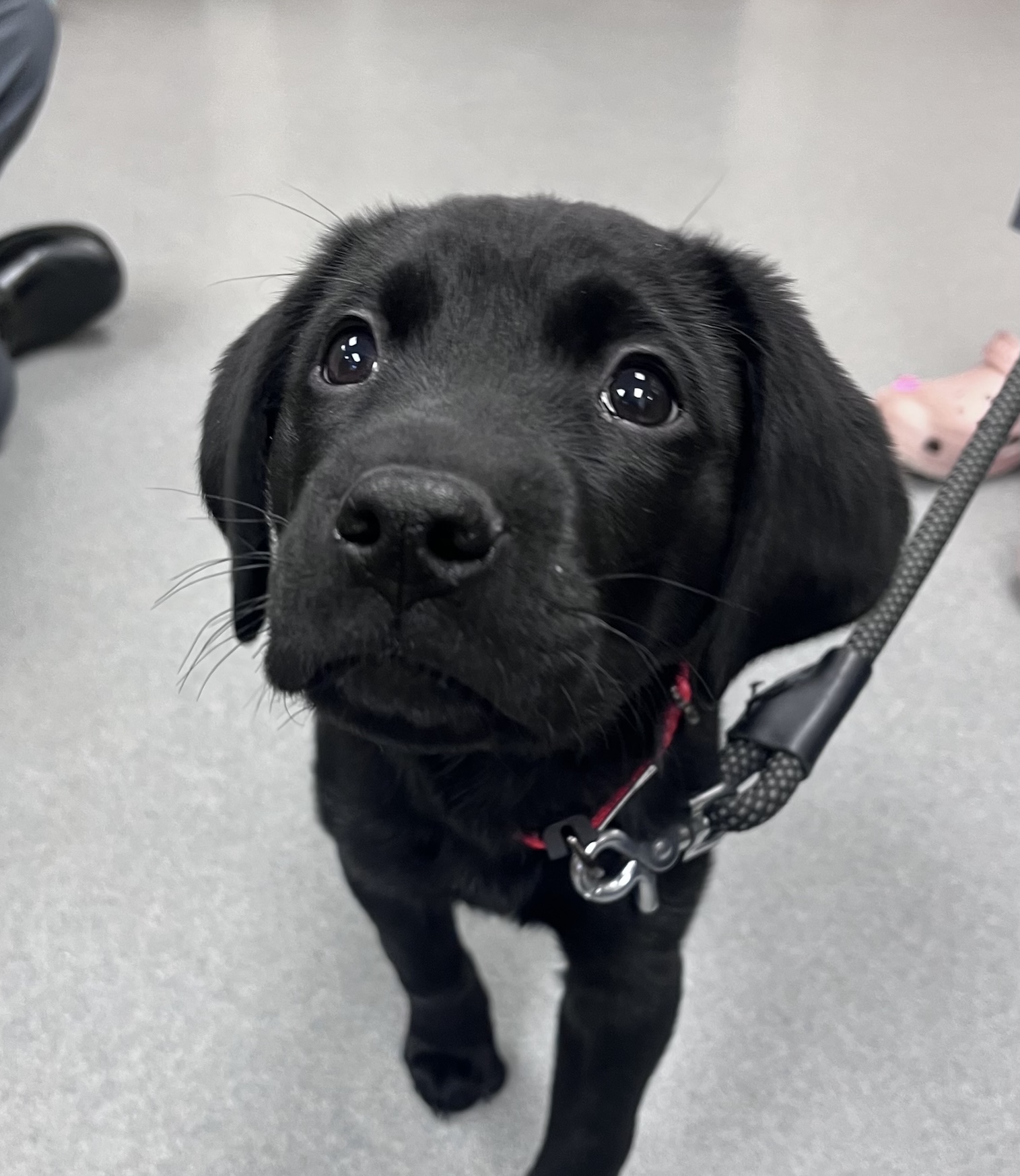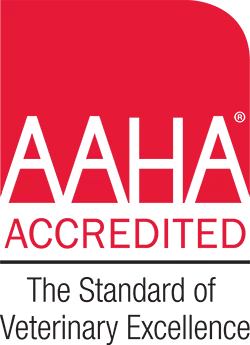So, you've got a puppy! What happens at that first vet visit?
 A physical exam is performed at each visit. Your veterinarian will assess your puppy’s health, development, and address any concerns you may have. Your puppy will be examined from nose to tail, including evaluation of:
A physical exam is performed at each visit. Your veterinarian will assess your puppy’s health, development, and address any concerns you may have. Your puppy will be examined from nose to tail, including evaluation of:
-
Eruption of adult teeth
-
Umbilical hernias
-
Heart murmurs
-
Growth and reproductive development
We will also recommend a transition visit around 10 months of age to discuss:
-
Switching to adult food
-
Appropriate feeding amounts
-
Continued flea/tick and heartworm prevention
When does your little pup need their shots?
Vaccines are essential to your puppy's long-term health. While nursing, puppies receive temporary immunity from their mother's milk that fades between 8–16 weeks. Vaccines are scheduled at 6–8 weeks, 12 weeks, and 16 weeks of age to build lasting protection.
Core Vaccines (recommended for all puppies)
-
Rabies: Fatal neurologic virus transmissible to humans. Required by law.
-
DHPP (Distemper Combo): Protects against:
-
Distemper: Severe viral illness
-
Hepatitis: Affects the liver
-
Parainfluenza: Respiratory infection
-
Parvovirus: Causes severe vomiting and diarrhea
-
-
Bordetella (Kennel Cough): Protects against airborne respiratory disease. Important for social dogs (boarding, grooming, daycare, dog parks).
-
Lyme: Transmitted by ticks. Common in New England. Protects against Lyme disease, which can affect joints and kidneys.
-
Leptospirosis: Bacterial infection affecting liver and kidneys. Zoonotic (can infect humans).
Non-Core Vaccines (based on lifestyle)
-
Canine Influenza: Respiratory virus. Consider for dogs exposed to large groups (boarding, daycare, grooming). Can be serious in rare cases.
Fleas and ticks: Do I really need to worry about them with a puppy?
Fleas and ticks are more than a nuisance—they spread diseases such as Lyme disease and tapeworms. A single flea can lay up to 2,000 eggs, leading to infestations.
-
Fleas bite within 5 minutes and can cause:
-
Anemia
-
Skin allergies (flea dermatitis)
-
Tapeworm transmission
-
-
Ticks transmit diseases, including Lyme disease, which is very common in New England.
We recommend Simparica Trio (monthly chewable) for safe and effective protection against fleas, ticks, and heartworm.
Lyme Disease: What exactly is it, and is my puppy at risk for it?
-
Caused by Borrelia burgdorferi, transmitted by deer ticks.
-
Common in New England—up to 75% of dogs may test positive.
-
Signs include: fever, lethargy, joint pain, poor appetite. Kidney complications can occur.
Prevention:
-
CR Lyme vaccine (safe and effective)
-
Year-round tick control
-
Annual testing (4dx/Accuplex)
Heartworm disease: What is this, and does my puppy need to be protected?
-
Spread by mosquitoes.
-
Worms live in the heart and lungs, leading to severe illness or death.
-
Symptoms may take 6 months to appear.
Prevention is key!
-
Safe, affordable, and nearly 100% effective
-
Available as monthly chewables or yearly injections (after 12 months of age)
Leptospirosis: What is it, and is that something my puppy could get?
-
Zoonotic bacterial infection affecting the liver and kidneys.
-
Spread through contact with urine-contaminated water or soil.
-
Common in dogs who:
-
Swim in lakes/rivers
-
Are exposed to wildlife or rodents
-
Symptoms: Fever, vomiting, increased thirst, jaundice, kidney/liver failure, and bleeding disorders.
Prevention:
-
Annual Leptospirosis vaccine
-
Avoid high-risk water sources
-
Immediate veterinary care if signs appear
Tummy troubles? What about those pesky intestinal parasites?
Very common in puppies. Some are zoonotic and transmissible to humans.
Common Parasites
-
Roundworms: Common in puppies. Transmitted via milk or ingestion. Zoonotic.
-
Hookworms: Cause anemia. Transmitted through skin or milk. Zoonotic.
-
Coccidia: Single-celled parasite. Causes diarrhea. Especially dangerous in puppies.
-
Whipworms: Cause bloody diarrhea and weight loss. Re-infection is common.
-
Tapeworms: Transmitted via fleas or prey. Cause scooting, anemia. Zoonotic.
-
Giardia: Spread through contaminated water. Causes diarrhea, weight loss. Zoonotic.
Prevention & Treatment:
-
Regular fecal testing
-
Monthly preventatives
-
Good hygiene (clean up feces, avoid standing water)
Why should I spay or neuter my puppy?
Recommended around 6–12 months, depending on breed and size.
Spaying (females):
-
Prevents ovarian/uterine cancers, unwanted pregnancy
-
Reduces risk of mammary tumors (especially if done before first heat)
Neutering (males):
-
Prevents testicular cancer
-
Reduces roaming, aggression, spraying
-
Lowers risk of prostate disease
What is gastropexy surgery, and is it something I should consider for my puppy?
A preventative surgery for large/deep-chested breeds to prevent GDV (bloat).
-
Performed during spay/neuter
-
Prevents stomach from twisting
-
Recovery is similar to routine surgeries
Recommended for breeds like: German Shepherds, Labs, Great Danes, Boxers
Microchips: What are they, and is it a good idea for my puppy to have one?
A permanent form of identification.
-
Size of a grain of rice
-
Implanted between the shoulder blades
-
Painless, safe, and lasts for life
1 in 3 pets go missing—microchipping increases the chance of being reunited if lost.
What's the best food to make sure my puppy grows up strong and healthy?
 We recommend feeding your puppy a good-quality puppy food, or large breed puppy food (if indicated). Recommended brands include Purina ProPlan, Science Diet, Iams, and Purina One
We recommend feeding your puppy a good-quality puppy food, or large breed puppy food (if indicated). Recommended brands include Purina ProPlan, Science Diet, Iams, and Purina One
You may feed your puppy dry, canned, or semi-moist food, as long as it is labeled as intended for growth, “complete and balanced,” and AAFCO tested and approved. Continue feeding puppy food until your pet reaches 12 months of age or has undergone spaying/neutering—this may vary depending on your dog’s breed and size.
We recommend “meal feeding” for puppies. Offer a measured amount of food 4–5 times daily for puppies aged 5–12 weeks. After 30 minutes, remove any uneaten food. If your puppy finishes in 3–4 minutes, you may need to increase the portion. Between 3–4 months, puppies typically reduce the number of meals they eat. At 6 months, transition to feeding twice daily.
Use the feeding charts on commercial puppy food packaging as a guideline based on age and weight, adjusting weekly as needed to maintain an ideal body condition. We suggest reducing the labeled recommendations by 20–25% to prevent overweight, particularly post spay/neuter.
Housetraining my puppy: Any secret tips and tricks to make this less painful for both of us?
Housetraining should begin as soon as your puppy comes home. The process length varies by puppy, so patience and consistency are key. Everyone in the home should follow the same routine to reinforce successful habits.
Tips for successful housetraining:
-
Use a crate that is appropriately sized—not too large—to discourage soiling inside.
-
Take your puppy outside immediately after waking, eating, or playing. Praise and reward them after elimination.
-
Avoid playtime before potty time to help them stay focused.
-
Use a consistent verbal cue like “go potty” or “do your business.”
-
Repeat this process every 30–45 minutes throughout the day, gradually increasing the interval.
-
Supervise your puppy closely. If you catch an accident in progress, interrupt and take them outside.
-
Until fully trained, limit their access to the house.
Your puppy isn’t being stubborn—they are learning! With consistency and patience, housetraining will become successful over time.
How can I teach my puppy to ring a bell to let me know when they need to got out?
- Hang a small bell by the door you use for potty trips. Ring the bell every time you take your puppy outside.
- Keep your puppy on a leash so you can step outside immediately after ringing the bell. Only go to the potty area, not for play.
- After a few days, lower the bell to your puppy’s nose level. Gently touch the bell to their nose to make it ring before going outside.
- After several repetitions, your puppy may start to ring the bell on their own.
- Once your puppy uses the bell independently, always take them outside immediately—this reinforces the behavior.
Is pet insurance really worth it for a new puppy?
Choosing pet insurance can feel overwhelming, with various coverage types, deductibles, and reimbursement limits available.
At Hampton Veterinary Hospital, we strongly recommend pet insurance—especially for unexpected illnesses or emergencies. We provide information on two trusted companies: Trupanion and Embrace. We encourage you to compare these and find the best fit for your needs.
A helpful independent resource is PetInsuranceReview.com, which compares plans, lists exclusions, and offers customer reviews. While we’re not affiliated with this site, we believe it provides valuable insight for choosing the right coverage.
At Hampton Veterinary Hospital, we’re here to help you every step of the way—from choosing the right food to mastering housetraining and exploring pet insurance options. Our team is passionate about supporting you and your puppy through every milestone. Have questions or need personalized guidance? Call us today at 603) 926-7978!

